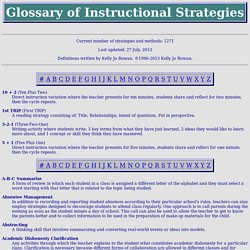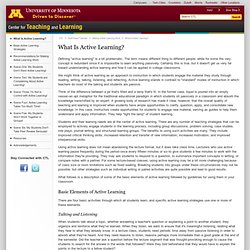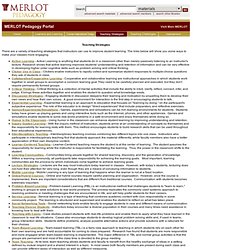

Glossary of Instructional Strategies. Current number of strategies and methods: 1271 Last updated: 27 July, 2013 Definitions written by Kelly Jo Rowan. ©1996-2013 Kelly Jo Rowan. 10 + 2 (Ten Plus Two) Direct instruction variation where the teacher presents for ten minutes, students share and reflect for two minutes, then the cycle repeats. 1st TRIP (First TRIP) A reading strategy consisting of: Title, Relationships, Intent of questions, Put in perspective. 3-2-1 (Three-Two-One) Writing activity where students write: 3 key terms from what they have just learned, 2 ideas they would like to learn more about, and 1 concept or skill they think they have mastered. 5 + 1 (Five Plus One) Direct instruction variation where the teacher presents for five minutes, students share and reflect for one minute, then the cycle repeats.

A-B-C Summarize A form of review in which each student in a class is assigned a different letter of the alphabet and they must select a word starting with that letter that is related to the topic being studied. Acronyms. What Is Active Learning? Defining "active learning" is a bit problematic.

The term means different thing to different people, while for some the very concept is redundant since it is impossible to learn anything passively. Certainly this is true, but it doesn't get us very far toward understanding active learning and how it can be applied in college classrooms. We might think of active learning as an approach to instruction in which students engage the material they study through reading, writing, talking, listening, and reflecting.
Active learning stands in contrast to "standard" modes of instruction in which teachers do most of the talking and students are passive. Think of the difference between a jar that's filled and a lamp that's lit. Students and their learning needs are at the center of active learning. Using active learning does not mean abandoning the lecture format, but it does take class time. Basic Elements of Active Learning Talking and Listening. Class Activities for Active Learning. Collaborative Teaching and Learning Strategies. Instructional Strategies for Online Courses. Instructional Strategies for Online Courses Effective online instruction depends on learning experiences appropriately designed and facilitated by knowledgeable educators.

Because learners have different learning stylesor a combination of styles, online educators should design activities multiple modes of learning in order to provide significant experiences for each class participant. In designing online courses, use multiple instructional strategies. Teaching models exist which apply to traditional higher education learning environments, and when designing courses for the online environment, these strategies should be adapted to the new environment. Traditionally, in a teacher-centered classroom, instructors control their environment because they have a monopoly on information. Online learning environments permit a range of interactive methodologies. Learning contracts connect educational needs to individual student needs. The discussion group Guided design Role playing Games The panel. Online Instructional Strategies. Creating a Syllabus for Learner-Centered Courses.
TeachingStrategies. Teaching Strategies There are a variety of teaching strategies that instructors can use to improve student learning.

The links below will show you some ways to make your classes more engaging. Active Learning - Active Learning is anything that students do in a classroom other than merely passively listening to an instructor's lecture. Research shows that active learning improves students' understanding and retention of information and can be very effective in developing higher order cognitive skills such as problem solving and critical thinking. Clicker Use in Class - Clickers enable instructors to rapidly collect and summarize student responses to multiple-choice questions they ask of students in class. Want to browse MERLOT’s entire collection on Teaching Strategies? Learning Theories Matrix.
"Engaging Learners in Small and Large Classes" by Vanneise Collins and Kun Huang. Instructional Strategies - Enhancing Education. Instructional-Strategies-for-Engaging-Learners.